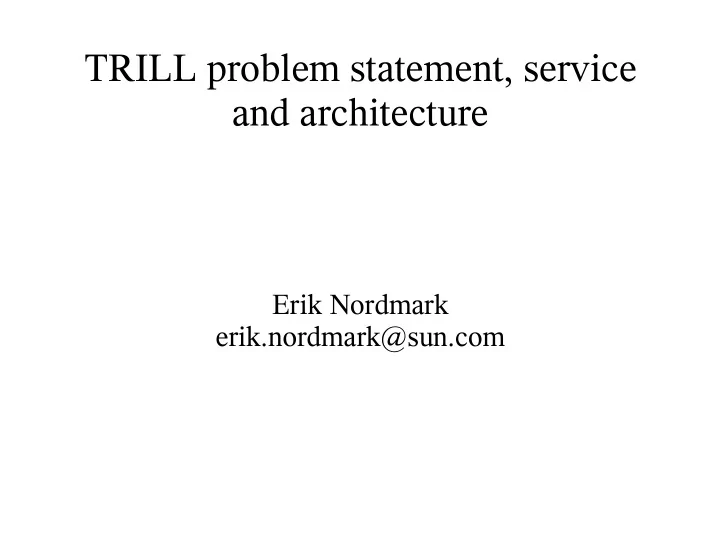

TRILL problem statement, service and architecture Erik Nordmark erik.nordmark@sun.com
Agenda ● Problem Statement ● TRILL model ● Goals from the proto-charter ● Service
Problem statement ● We have L2 solutions which have many benefits – IEEE 802 networks used as example her, but could be Fibrechannel, MPLS or something else ● We have L3 technology which have many benefits ● Desire to combine these technologies to create the best of both worlds for a LAN setting – LAN = broadcast domain
Motivations ● Different for different participants – Better robustness than STP (but IEEE 802.1D-2004 would satisfy that) – Better aggregate bandwidth than L2 bridges – Better latency due to pair-wise shortest paths – Be able to interconnect different L2 types e.g., for home networking?? – Be able to build larger LANs??
Model Router Router Host LAN Host Host LAN service
Model with TRILL devices Router T Router T Host Host T T Host LAN service
Model with TRILL and bridges Router T Router B T B B Host Host B B T T Host LAN service
TRILL overlay approach Router T Router B T B B Host Host B B T T Encapsulation + link state Host LAN routing protocol service
Goals from proto-charter (1) ● Zero configuration of the hybrid devices ● Ability for hosts to move without changing their IP address ● It should be possible to forward packets using pair-wise shortest paths, and exploit the redundant paths through the network for increased aggregate bandwidth ● Possible optimizations for ARP and Neighbor Discovery packets (potentially avoid flooding all the time)
Goals (2) ● Support Secure Neighbor Discovery ● The packet header should have a hop count for robustness in the presence of temporary routing loops ● Nodes should be able to have multiple attachments to the network ● No delay when a new node is attached to the network
Goals (3) ● Multicast should work (and after a re-charter it might make sense to look at optimizations for IP multicast) ● Be no less secure than existing bridges (and explore whether the protocol can make "L2 address theft" either harder, or easier to detect) ● No changes to hosts, routers, or L2 bridges ● Q: interconnect different L2 technologies? ● Supporting non-IP protocols
LAN service ● Broadcast domain ● Reordering and duplication – Small probability only when network topology changes ● MTU – Most LANs have a uniform MTU between all stations
IEEE 802.1 specific services ● Priority ● VLANs ● Makes sense to provide those in TRILL
Which LAN service does IP need? ● There is the option to special case IPv4/IPv6/ARP because – The receiver does not inspect the L2 frame thus e.g. L2 source address can be mucked with (e.g., if it makes it easier to interwork with bridges) – Only known exception is a MIPv4 optimization to not use any encapsulation between FA and MN (hence ARP can't be used, etc, etc) ● Better if TRILL doesn't have to handle IP/ARP differently than other packets
Questions?
Recommend
More recommend